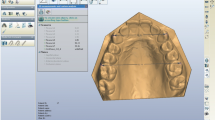Abstract
Digital imaging of dental casts has become an alternative to conventional cast analysis in orthodontic treatment planning. The reproducibility of angular measurements made on virtual digital models has not as yet been evaluated. In order to study reproducibility for and agreement between a conventional analysis technique and virtual 3D imaging, 20 dental casts from subjects in the early mixed dentition, were measured twice with each technique by two orthodontists. Variables of interest were incisor rotation, angulation and irregularity, arch width, arch circumference, overjet, and overbite. Standard deviation (Dahlberg 1940) and coefficient of variation were used for evaluation of reproducibility. Mean differences between methods and examiners, correlation between mean differences and mean levels and 95% limits of agreement were used for describing systematic errors. The conventional technique showed less intraexaminer variation for angular variables than the 3D imaging method. Linear variables, with the exception of overbite, showed no clear trend as regards differences in reproducibility between the two methods. In general, examiner 1 showed less intraexaminer variation than examiner 2. The mean differences between the two methods expressed higher values for assessment of rotations with the O3DM method. Both angular and linear variables exhibited poor 95% limits of agreement. The conventional technique showed better overall reproducibility and thus appears to be more suitable for scientific work. However, the reproducibility attained by O3DM is clearly acceptable for clinical use. The two methods should not be used interchangeably.






Similar content being viewed by others
References
Dahlberg G: Statistical Methods for Medical and Biological Students. London: George Allen & Unwin Ltd, 1940, pp 122–132
Edwards JG: A long-term prospective evaluation of the circumferential supracrestal fiberotomy in alleviating orthodontic relapse. Am J Orthod Dentofacial Orthop 93:380–387, 1988
Reitan K: Tissue rearrangement during the retention of orthodontically rotated teeth. Angle Orthod 29:105–113, 1959
Surbeck B, Årtun J: Associations between initial, posttreatment and postretention alignment of maxillary anterior teeth. Am J Orthod 113(2):186–195, 1998
Little RM: The irregularity index: a quantitative score of mandibular anterior alignment. Am J Orthod 68:554–563, 1975
Naraghi S, Andren A, Kjellberg H, Mohlin BO: Relapse tendency after orthodontic correction of upper front teeth retained with a bonded retainer. Angle Orthod 76:570–576, 2006
Little RM, Riedel RA, Artun J: An evaluation of changes in mandibular anterior alignment from 10 to 20 years postretention. Am J Orthod Dentofacial Orthop 93:423–428, 1988
Gracco A, Buranello M, Cozzani M, Siciliani G: Digital and plaster models: a comparison of measurements and times. Prog Orthod 8:252–259, 2007
Quimby ML, Vig KW, Rashid RG, Firestone AR: The accuracy and reliability of measurements made on computer-based digital models. Angle Orthod 74:298–303, 2004
Zilberman O, Huggare JA, Parikakis KA: Evaluation of the validity of tooth size and arch width measurements using conventional and three-dimensional virtual orthodontic models. Angle Orthod 73:301–306, 2003
Asquith J, Gillgrass T, Mossey P: Three-dimensional imaging of orthodontic models: a pilot study. Eur J Orthod 29:517–522, 2007
Hildebrand JC, Palomo JM, Palomo L, Sivik M, Hans M: Evaluation of a software program for applying the American Board of Orthodontics objective grading system to digital casts. Am J Orthod Dentofacial Orthop 133:283–289, 2008
Mok CW, Zhou L, McGrath C, Hagg U, Bendeus M: Digital images as an alternative to orthodontic casts in assessing malocclusion and orthodontic treatment need. Acta Odontol Scand 65:362–368, 2007
Okunami TR, Kusnoto B, BeGole E, Evans CA, Sadowsky C, Fadavi S: Assessing the American Board of Orthodontics objective grading system: digital vs plaster dental casts. Am J Orthod Dentofacial Orthop 131:51–56, 2007
Stevens DR, Flores-Mir C, Nebbe B, Raboud DW, Heo G, Major PW: Validity, reliability, and reproducibility of plaster vs digital study models: comparison of peer assessment rating and Bolton analysis and their constituent measurements. Am J Orthod Dentofacial Orthop 129:794–803, 2006
Costalos PA, Sarraf K, Cangialosi TJ, Efstratiadis S: Evaluation of the accuracy of digital model analysis for the American Board of Orthodontics objective grading system for dental casts. Am J Orthod Dentofacial Orthop 128:624–629, 2005
Mullen SR, Martin CA, Ngan P, Gladwin M: Accuracy of space analysis with emodels and plaster models. Am J Orthod Dentofacial Orthop 132:346–352, 2007
Santoro M, Galkin S, Teredesai M, Nicolay OF, Cangialosi TJ: Comparison of measurements made on digital and plaster models. Am J Orthod Dentofacial Orthop 124:101–105, 2003
Tomassetti JJ, Taloumis LJ, Denny JM, Fischer Jr., JR: A comparison of 3 computerized Bolton tooth-size analyses with a commonly used method. Angle Orthod 71:351–357, 2001
Bland M: An Introduction to Medical Statistics, Oxford: Oxford University Press, 1991
Altman DG: Practical Statistics for Medical Research, UK: Chapman & Hall/CRC, 1999
Acknowledgements
We would like to thank Christian Melsen, O3DM, Aarhus, Denmark and Bengt Schmeling, Ilexis AB, Linköping, Sweden for technical advice, statistical consultant Anders Magnuson, Örebro University Hospital for statistical expertise and Dr. Björn Svensson, Department of Oral Radiology, Postgraduate Dental Education Center, Örebro, Sweden for fruitful discussions and manuscript work.
Fundings
This study was supported by grants from the Research Committee of Folktandvården, Örebro County Council, Örebro, Sweden. No commercial/financial relationship, interest, or association that might pose a conflict of interest in connection with the article has been present.
Author information
Authors and Affiliations
Corresponding author
Rights and permissions
About this article
Cite this article
Sjögren, A.P.G., Lindgren, J.E. & Huggare, J.Å.V. Orthodontic Study Cast Analysis—Reproducibility of Recordings and Agreement Between Conventional and 3D Virtual Measurements. J Digit Imaging 23, 482–492 (2010). https://doi.org/10.1007/s10278-009-9211-y
Received:
Revised:
Accepted:
Published:
Issue Date:
DOI: https://doi.org/10.1007/s10278-009-9211-y




